

Compact Muon Solenoid
LHC, CERN
| CMS-PAS-EXO-16-026 | ||
| Search for heavy composite Majorana neutrinos produced in association with a lepton and decaying into a same-flavour lepton plus two quarks at $ \sqrt{s} = $ 13 TeV with the CMS detector | ||
| CMS Collaboration | ||
| August 2016 | ||
| Abstract: We present a search for physics beyond the standard model in the final state with two same-flavour leptons (electrons or muons) and two quarks. The results of the measurement are interpreted in the framework of a recently proposed model, in which a heavy Majorana neutrino stems from a composite scenario. The analysis is performed using proton-proton collisions at $ \sqrt{s} = $ 13 TeV recorded by the CMS experiment at the CERN LHC. The data correspond to an integrated luminosity of 2.3 fb$^{-1}$ collected in 2015. The observed data are in good agreement with the standard model prediction. An upper limit at 95% CL on the product of the cross section of the heavy composite Majorana neutrino, $N$, produced in association with a lepton times branching fraction of $N$ into a same-flavour lepton and a quark pair is calculated as a function of its mass. In this model, the presence of the heavy composite Majorana neutrinos is excluded for masses up to 4.35 TeV and 4.50 TeV for a value of $\Lambda$ of 5 TeV, having analysed the $\mathrm{ee qq}$ channel and the $\mu\mu\mathrm{qq}$ channel, respectively. | ||
|
Links:
CDS record (PDF) ;
inSPIRE record ;
CADI line (restricted) ;
These preliminary results are superseded in this paper, PLB 775 (2017) 315. The superseded preliminary plots can be found here. |
||
| Figures | |

png pdf |
Figure 1:
The fermion interaction as sum of the gauge and contact contributions. |
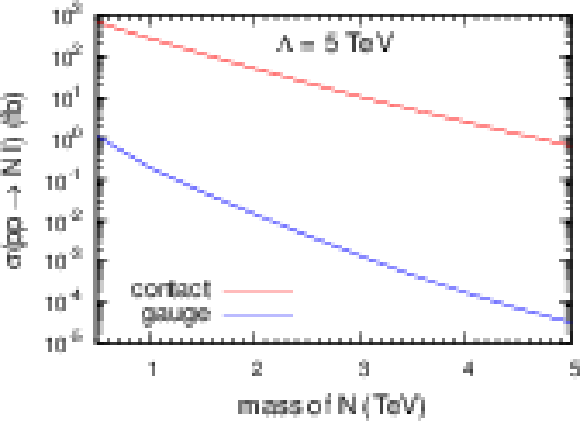
png pdf |
Figure 2-a:
(a) Production cross section of the heavy composite Majorana neutrino for gauge and contact interaction at $\Lambda = $ 5 TeV. (b) Decay amplitude of the heavy composite Majorana neutrino for $\Lambda =$ 5 TeV as a function of its mass. The figures illustrate results of calculations based on [11]. |

png pdf |
Figure 2-b:
(a) Production cross section of the heavy composite Majorana neutrino for gauge and contact interaction at $\Lambda = $ 5 TeV. (b) Decay amplitude of the heavy composite Majorana neutrino for $\Lambda =$ 5 TeV as a function of its mass. The figures illustrate results of calculations based on [11]. |
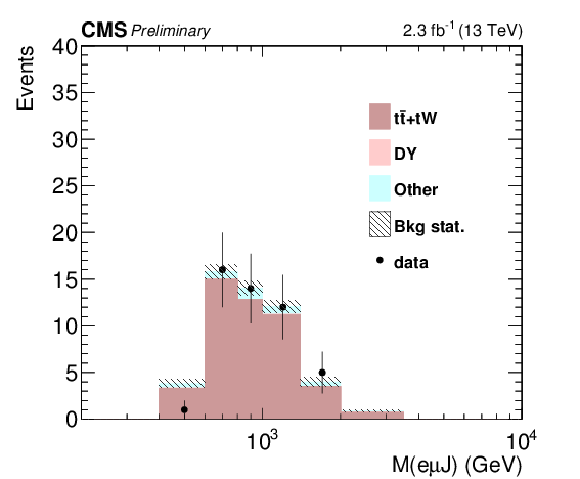
png pdf |
Figure 3-a:
Data events in the $e\mu qq$ control regions defined to estimate the $t\bar{t}$ plus $tW$ contribution in the $ee qq$ (a) and $\mu \mu qq$ (b) channels, compared to the MC expectations for the background. |
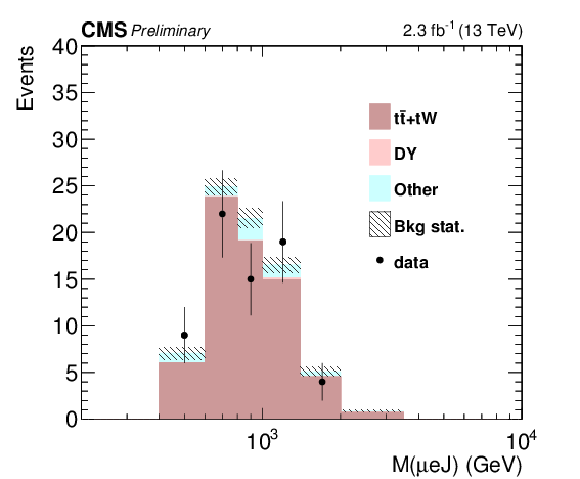
png pdf |
Figure 3-b:
Data events in the $e\mu qq$ control regions defined to estimate the $t\bar{t}$ plus $tW$ contribution in the $ee qq$ (a) and $\mu \mu qq$ (b) channels, compared to the MC expectations for the background. |
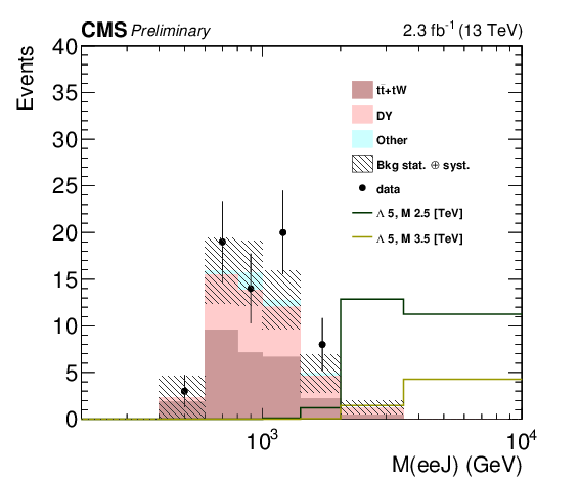
png pdf |
Figure 4-a:
Distribution of the variable $M(\ell \ell J)$ for the data (black points), the estimated SM backgrounds (stackplots), and the signal (lines) having considered the parameters $\Lambda =$ 5 TeV and two masses of N equal to 2500 and 3500 GeV , for the $eeqq$ (a) and the $\mu \mu qq$ (b) channels. The error bars stand for the statistical and systematic uncertainty. The last bin includes the overflow entries. |
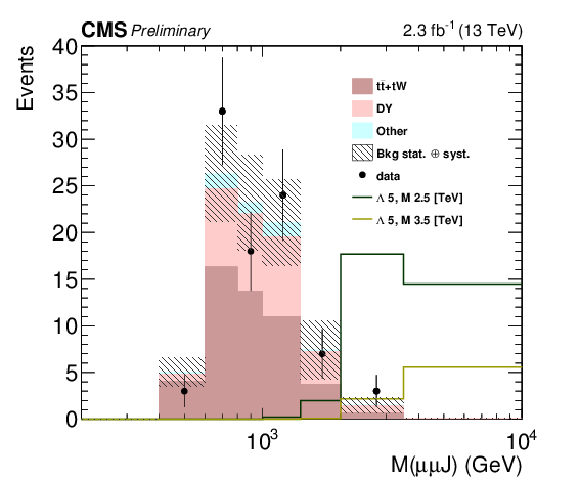
png pdf |
Figure 4-b:
Distribution of the variable $M(\ell \ell J)$ for the data (black points), the estimated SM backgrounds (stackplots), and the signal (lines) having considered the parameters $\Lambda =$ 5 TeV and two masses of N equal to 2500 and 3500 GeV , for the $eeqq$ (a) and the $\mu \mu qq$ (b) channels. The error bars stand for the statistical and systematic uncertainty. The last bin includes the overflow entries. |
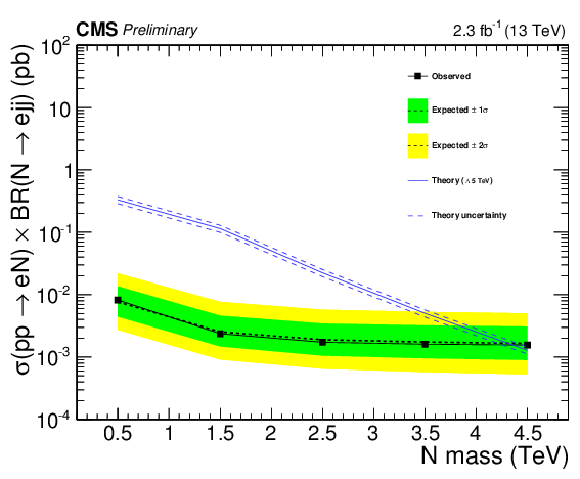
png pdf |
Figure 5-a:
The observed 95% CL upper limits (solid black lines) on $\sigma (pp \rightarrow \ell N) \times {\cal B}(N \rightarrow \ell qq)$, obtained in the analysis of the $ee qq$ (a) and the $\mu \mu qq$ (b) final states, as a function of the mass of the heavy composite Majorana neutrino, $N$. The corresponding expected limits are shown by the dotted lines, and the coloured bands represent expected variation of the limit to one (green) and two (yellow) standard deviations. The blue curves indicates the theoretical prediction of $\sigma (pp \rightarrow \ell N) \times {\cal B}(N \rightarrow \ell qq)$ and its uncertainty for $\Lambda =$ 5 TeV and different values of the mass of $N$. |

png pdf |
Figure 5-b:
The observed 95% CL upper limits (solid black lines) on $\sigma (pp \rightarrow \ell N) \times {\cal B}(N \rightarrow \ell qq)$, obtained in the analysis of the $ee qq$ (a) and the $\mu \mu qq$ (b) final states, as a function of the mass of the heavy composite Majorana neutrino, $N$. The corresponding expected limits are shown by the dotted lines, and the coloured bands represent expected variation of the limit to one (green) and two (yellow) standard deviations. The blue curves indicates the theoretical prediction of $\sigma (pp \rightarrow \ell N) \times {\cal B}(N \rightarrow \ell qq)$ and its uncertainty for $\Lambda =$ 5 TeV and different values of the mass of $N$. |
| Tables | |
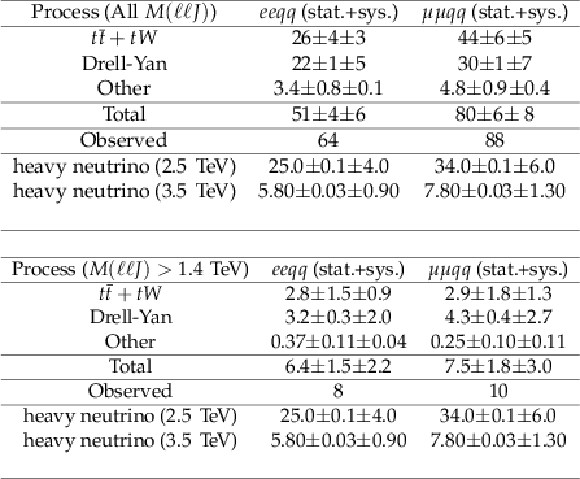
png pdf |
Table 1:
Number of events observed in data compared to expected background yields and hypothetical heavy composite Majorana neutrino signals of mass 2.5 and 3.5 TeV . The expected signal yields are computed at LO accuracy. The first uncertainty quoted on the background and MC signal yields represents the statistical one, while the second uncertainty is the systematic one. The top table gives inclusive yields, while the bottom one gives yields in the region where $M(\ell \ell J) >$ 1.4 TeV . |
| Summary |
| A search for new physics beyond the standard model has been performed considering a new model [11] based on a heavy Majorana neutrino, $N$, that originates from a composite scenario. We have used the 2015 dataset corresponding to an integrated luminosity of 2.3 fb$^{-1}$ collected by the CMS detector in pp collisions at $\sqrt{s} = $13 TeV. The data is in good agreement with the standard model prediction and we set an upper limit at 95% CL on $\sigma(pp \rightarrow \ell N) \times {\cal B}(N \rightarrow \ell qq)$. We have analysed the the $ee qq$ ($\mu\mu qq$) channel, for which we can exclude a heavy composite Majorana neutrino of mass up to 4.35 (4.50) TeV, for a value of $\Lambda$ of 5 TeV. The observed limits are comparable to the expectations of 4.30 (4.50) TeV in the $ee qq$ ($\mu\mu qq$) channel. This measurement represents the first search that considers as benchmark scenario the model described in [11]. |
| References | ||||
| 1 | J. C. Pati, A. Salam, and J. A. Strathdee | Are quarks composite? | PLB 59 (1975) 265 | |
| 2 | H. Harari | Composite models for quarks and leptons | Physics Reports 104 (1984) 159 | |
| 3 | O. W. Greenberg and C. A. Nelson | Composite Models of Leptons | PRD 10 (1974) 2567 | |
| 4 | H. Terazawa | t quark mass predicted from a sum rule for lepton and quark masses | PRD 22 2921--2921 | |
| 5 | E. Eichten, K. D. Lane, and M. E. Peskin | New Tests for Quark and Lepton Substructure | PRL 50 (1983) 811--814 | |
| 6 | N. Cabibbo, L. Maiani, and Y. Srivastava | Anomalous Z Decays: Excited Leptons? | PLB 139 (1984) 459 | |
| 7 | U. Baur, M. Spira, and P. M. Zerwas | Excited Quark and Lepton Production at Hadron Colliders | PRD 42 (1990) 815--824 | |
| 8 | O. Panella, C. Carimalo, and Y. N. Srivastava | Production of like sign dileptons in pp collisions through composite Majorana neutrinos | PRD 62 (2000) 015013 | hep-ph/9903253 |
| 9 | O. Panella, C. Carimalo, Y. N. Srivastava, and A. Widom | Neutrinoless Double Beta Decay with Composite Neutrinos | PRD 56 (1997) 5766--5775 | hep-ph/9701251 |
| 10 | O. Panella and Y. N. Srivastava | Bounds on compositeness from neutrinoless double beta decay | PRD 52 (1995) 5308--5313 | hep-ph/9411224 |
| 11 | R. Leonardi , L. Alunni, F. Romeo, L. Fano', and O. Panella | Hunting for heavy composite Majorana neutrinos at the LHC | Submitted on EPJC (2015) | 1510.07988v2 |
| 12 | CMS Collaboration | Search for heavy neutrinos and W bosons with right-handed couplings in proton-proton collisions at $ \sqrt{s}= 8 $ TeV | The European Physical Journal C 74 (2014) 1--23 | |
| 13 | CMS Collaboration | Search for pair production of first and second generation leptoquarks in proton-proton collisions at $ \sqrt{s}=8 $ TeV | PRD 93 (2016) 032004 | |
| 14 | ATLAS Collaboration | Search for excited electrons and muons with 13~fb$ ^{-1} $ of proton--proton collisions at $ \sqrt{s}=8 $ TeV with the ATLAS detector | ATLAS-CONF-2012-146 (Nov, 2012) | |
| 15 | CMS Collaboration | Search for excited leptons in proton-proton collisions at $ \sqrt{s}=8 $ ~TeV | JHEP 03 (2016) 125 | CMS-EXO-14-015 1511.01407 |
| 16 | ATLAS Collaboration | Search for heavy neutrinos and right-handed $ W $ bosons in events with two leptons and jets in $ pp $ collisions at $ \sqrt{s}= 7 $ TeV with the ATLAS detector | The European Physical Journal C 72 (2012) 1--22 | |
| 17 | ATLAS Collaboration | Search for heavy Majorana neutrinos with the ATLAS detector in pp collisions at $ \sqrt{s} $=8 TeV | Journal of High Energy Physics (2015) 1--44 | |
| 18 | CMS Collaboration | Search for heavy Majorana neutrinos in $ \mu^\pm\mu^\pm + jets $ events in proton-proton collisions at $ \sqrt{s}=8 $ TeV | Physics Letters B 748 (2015) 144 -- 166 | |
| 19 | CMS Collaboration | Search for heavy Majorana neutrinos in $ e^\pm e^\pm + jets $ and $ e^\pm\mu^\pm + jets $ events in proton-proton collisions at $ \sqrt{s}=8 $ TeV | Accepted by JHEP | |
| 20 | CMS Collaboration | Search for heavy neutrinos and third-generation leptoquarks in final states with two hadronically decaying $ \tau $ leptons and two jets in proton-proton collisions at $ \sqrt{s}=13 $ TeV | CMS-PAS-EXO-16-016 | CMS-PAS-EXO-16-016 |
| 21 | CMS Collaboration | The CMS experiment at the CERN LHC | JINST 3 (2008) S08004 | CMS-00-001 |
| 22 | CMS Collaboration | CMS Luminosity Measurement for the 2015 Data Taking Period | ||
| 23 | A. Belyaev, N. D. Christensen, and A. Pukhov | CalcHEP 3.4 for collider physics within and beyond the Standard Model | CPC 184 (2013) 1729--1769 | 1207.6082 |
| 24 | Ball, R.D., Bertone, V. et al. | Parton distributions for the LHC Run II | JHEP 04 (2015) 040 | 1410.8849 |
| 25 | S. Frixione, P. Nason, and C. Oleari | Matching NLO QCD computations with Parton Shower simulations: the POWHEG method | JHEP 11 (2007) 070 | |
| 26 | J. Alwall at al. | MadGraph 5: Going Beyond | JHEP 1106 (2011) 128 | |
| 27 | T. Sj\"ostrand, S. Mrenna, and P. Skand | A Brief introduction to PYTHIA 8.1 | Comput. Phys. Comm. 178 (2008) 852 | |
| 28 | H. L. Lai et al. | Global QCD Analysis of Parton Structure of the Nucleon: CTEQ5 Parton Distributions | The European Physical Journal C 12 (2000) 375--392 | hep-ph/9903282 |
| 29 | GEANT4 Collaboration | Geant4 - a simulation toolkit | NIMA 506 (2003) 250 | |
| 30 | CMS Collaboration | Performance of Electron Reconstruction and Selection with the CMS Detector in Proton-Proton Collisions at $ \sqrt{s} $ = 8 TeV | JINST 10 (2015) P06005 | CMS-EGM-13-001 1502.02701 |
| 31 | CMS Collaboration | Muon Reconstruction and Identification Improvements for Run-2 and First Results with 2015 Run Data | CMS Detector Performance Summary CMS-DP-15-015 | |
| 32 | M. Cacciari, G. P. Salam, and G. Soyez | FastJet user manual | CERN--PH--TH (2011) 297 | 1111.6097 |
| 33 | M. Cacciari and G. P. Salam | Dispelling the $ N^3 $ myth for the $ k_t $ jet-finder | PLB 641 (2006) 57--61 | hep-ph/0512210 |
| 34 | CMS Collaboration | Search for a Narrow Resonance Produced in 13 TeV pp Collisions Decaying to Electron Pair or Muon Pair Final States | CDS | |
| 35 | J. Butterworth et al. | PDF4LHC recommendations for LHC Run II | 1510.03865 | |
| 36 | CMS Collaboration | CMS Luminosity Measurement for the 2015 Data Taking Period | ||
| 37 | A. L. Read | Presentation of search results: the $ CL_s $ technique | JPG: Nucl. Part. Phys. 28 (2002) 2693 | |

|
Compact Muon Solenoid LHC, CERN |

|

|

|

|

|

|